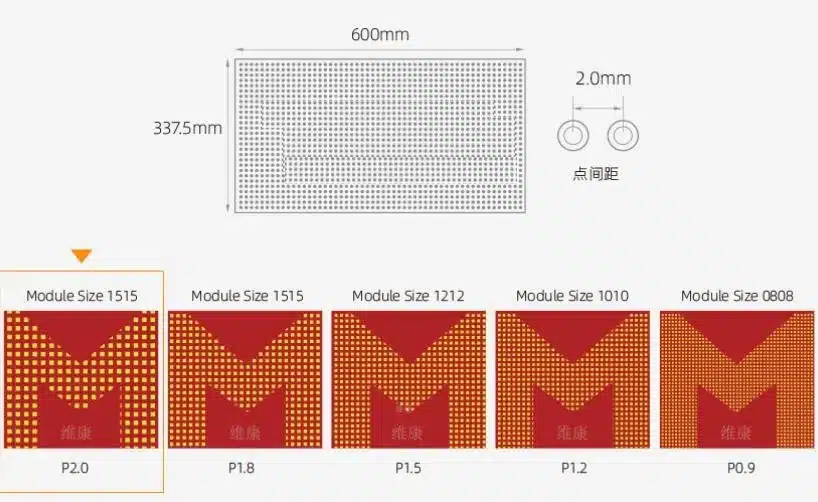LED Display Design & Installation: Essential Calculation Methods and Guidelines

zWith the widespread use of LED displays across retail stores, large plazas, conference rooms, command centers, and grand opening ceremonies, understanding how to design and install LED displays is essential. This guide provides detailed calculations and installation techniques to help you optimize your LED display projects.
1️⃣ Screen Size Calculation Methods
(1) Pixel Pitch Calculation Method
The pixel pitch is the distance between the center of one LED pixel to another adjacent pixel.
For example, in a P10 LED module (320mm x 160mm):
- Each module has 32 horizontal pixels and 16 vertical pixels.
- The pixel pitch = 10mm (P10 means each pixel is spaced 10mm apart).
- If the screen width is W meters, and height is H meters, then:
- Width (m) = Total modules × 0.32m
- Height (m) = Total modules × 0.16m
(2) Aspect Ratio Calculation Method
Common LED screen aspect ratios: ✅ 4:3 (Standard format)
✅ 16:9 (Widescreen format)
Formulas:
For 4:3 aspect ratio
- Width = √(Area) × 0.8
- Height = √(Area) × 0.6
For 16:9 aspect ratio
- Width = √(Area) × 0.871
- Height = √(Area) × 0.481
Example:
For a 9㎡ LED screen with a 4:3 aspect ratio:
- Width = √9 × 0.8 = 3m
- Height = √9 × 0.6 = 2m
⚠️ Considerations:
- Higher resolution screens require larger screen sizes for optimal viewing.
- Consider bezels, panel gaps, and frame structures when designing your LED screen.
2️⃣ How to Calculate the Number of LED Modules?
Each LED screen consists of multiple modules, and their number can be calculated using the following formula:
🔹 Total number of modules = (Total area) ÷ (Module width × Module height)
Example Calculation
A P16 outdoor monochrome LED display with 10㎡ total area:
10㎡÷(0.256m×0.128m)=305.17≈305 modules10㎡ ÷ (0.256m × 0.128m) = 305.17 ≈ 305 \text{ modules}10㎡÷(0.256m×0.128m)=305.17≈305 modules
To calculate more accurately, use:
(Modules along width)×(Modules along height)=Total modules\text{(Modules along width)} × \text{(Modules along height)} = \text{Total modules}(Modules along width)×(Modules along height)=Total modules
Example:
A P16 display of 5m (width) × 2m (height)
- Width modules: 5m ÷ 0.256m = 19.5 ≈ 20 modules
- Height modules: 2m ÷ 0.128m = 15.6 ≈ 16 modules
- Total modules = 20 × 16 = 320 modules
3️⃣ LED Display Viewing Distance Calculation
✔ RGB Color Blending Distance
Viewing Distance=Pixel Pitch (mm)×500/1000\text{Viewing Distance} = \text{Pixel Pitch (mm)} × 500 / 1000Viewing Distance=Pixel Pitch (mm)×500/1000
✔ Minimum Smooth Image Viewing Distance
Min Distance=Pixel Pitch (mm)×1000/1000\text{Min Distance} = \text{Pixel Pitch (mm)} × 1000 / 1000Min Distance=Pixel Pitch (mm)×1000/1000
✔ Optimal Viewing Distance (Best Clarity)
Best Distance=Pixel Pitch (mm)×3000/1000\text{Best Distance} = \text{Pixel Pitch (mm)} × 3000 / 1000Best Distance=Pixel Pitch (mm)×3000/1000
✔ Maximum Viewing Distance
Max Distance=Screen Height (m)×30\text{Max Distance} = \text{Screen Height (m)} × 30Max Distance=Screen Height (m)×30
Example: For a P10 screen:
- Minimum Viewing Distance = 10mm × 1 = 10m
- Optimal Viewing Distance = 10mm × 3 = 30m
- Maximum Viewing Distance = Screen Height × 30
4️⃣ LED Display Power Calculation
The power consumption of an LED display is calculated using:
P=U×IP = U \times IP=U×I
Where:
- P = Power (W)
- U = Voltage (V)
- I = Current (A)
✅ Power Calculation by Power Supply
- A single 5V 40A power supply provides: 5V×40A=200W5V × 40A = 200W5V×40A=200W
- Total Power Required = (Number of Power Supplies) × (Power per Supply)
Example:
A 9㎡ indoor dual-color LED display requires 13 power supplies (calculated separately).
Total Power=13×200W=2600W\text{Total Power} = 13 × 200W = 2600WTotal Power=13×200W=2600W
⚠️ Factors Affecting Power Calculation:
- Peak vs. Average Power
- Brightness settings (higher brightness consumes more power)
- Environmental factors (indoor vs. outdoor)
5️⃣ LED Display Brightness Calculation
🔹 Brightness per Pixel Calculation:
Each pixel contributes different brightness levels:
Pixel Brightness=Red×2+Green+Blue\text{Pixel Brightness} = \text{Red} × 2 + \text{Green} + \text{Blue}Pixel Brightness=Red×2+Green+Blue
Example Calculation:
A P16 outdoor display with 3906 pixels/m² and the following LED brightness:
- Red = 800 mcd
- Green = 2300 mcd
- Blue = 350 mcd
Total Brightness=(800×2+2300+350)×3906÷1000÷4\text{Total Brightness} = (800 × 2 + 2300 + 350) × 3906 ÷ 1000 ÷ 4Total Brightness=(800×2+2300+350)×3906÷1000÷4 =4150 cd/m²= 4150 \text{ cd/m²}=4150 cd/m²
✔ Standard LED Brightness Requirements:
- Indoor LED Screens: > 800 cd/m²
- Semi-Outdoor LED Screens: > 2000 cd/m²
- Outdoor LED Screens (North-Facing): > 4000 cd/m²
- Outdoor LED Screens (South-Facing): > 8000 cd/m²
6️⃣ LED Display Resolution Calculation
Resolution Calculation Formula:
Resolution=(Screen Width÷Pixel Pitch)×(Screen Height÷Pixel Pitch)\text{Resolution} = (\text{Screen Width} ÷ \text{Pixel Pitch}) × (\text{Screen Height} ÷ \text{Pixel Pitch})Resolution=(Screen Width÷Pixel Pitch)×(Screen Height÷Pixel Pitch)
Example:
A 4m × 2m LED screen with P2 pixel pitch
(4000mm÷2mm)×(2000mm÷2mm)=2000×1000=2,000,000 pixels(4000mm ÷ 2mm) × (2000mm ÷ 2mm) = 2000 × 1000 = 2,000,000 \text{ pixels}(4000mm÷2mm)×(2000mm÷2mm)=2000×1000=2,000,000 pixels
📢 Higher resolutions require smaller pixel pitches but increase costs.
7️⃣ Standard Aspect Ratios for LED Displays
- Graphic & Text Displays: Custom ratio based on content
- Video Displays: 4:3 or 16:9
- Ideal Aspect Ratio: 16:9 for best viewing experience
8️⃣ Installation Requirements for LED Screens
✔ Power Supply Requirements
- 220V Supply: Live, Neutral, Ground
- 380V Supply: Three-phase live, neutral, ground
- >1kW Screens: Require step-down transformers
✔ Communication Requirements
- Follow installation specs for communication cables
- Avoid running communication cables alongside power cables
✔ Installation Guidelines
- Screens must be perfectly level
- Suspended screens need height-adjustable mounting rods
- Wall-mounted screens require anti-fall hooks
- Freestanding screens need support bolts
📌 Conclusion
This guide covered essential LED display calculations, including size, power, brightness, resolution, viewing distance, and installation guidelines.
📢 Need More LED Display Insights? Follow Our Updates for Expert Advice! 🚀